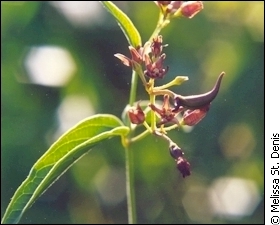| Spotlight on purple loosestrife: A beautiful killer
• also known as
spiked loosestrife, swamp loosestrife
• existed as early
as 1753 when it was described by Linnaeus
• native to Europe,
it was probably introduced to North America in the
early 1800s
• brought here
through ballast water, on imported sheep, or in
livestock feed
• by 1830, it was
well-established in the New England states
• up to 2.7 million
seeds per plant, per year
• kills native
species and spreads rapidly
• have attempted
different methods of biological, chemical, and
physical control of the plant
• six species of
insects have been identified as having potential for
the biological control of purple loosestrife — including various beetles and weevils
|
It may sound like something out of a bad horror movie, but if you live in Ontario, dog-strangling vine could be coming to a field or ravine near you.
The vine, whose scientific name is vincetoxicum rossicum, has invaded much of Ontario.
Naomi Cappuccino, a Carleton University biology professor, has been studying the plant for the past year in an effort to find out how the plant's spread can be stopped. She also wants to determine how to kill the plants that are already thriving.
Fear of the unknown
One of the problems, says Cappuccino, is that so little is known about the plant's biology.
 |
| The flower and seed pod of the dog-strangling vine. |
Cappuccino's current research looks at the survivorship of the plants — how long the plants live, how seeds are dispersed, and how the population as a whole grows.
Dog-strangling vine is an invasive alien, which means it's not native to Canada and it kills most other species when it moves into a new locale. It takes over ecosystems, damaging previously existing bio-diversity.
Because it is alien to Canada, the plant doesn't have any natural enemies. In its native Europe, the plant is not considered a threat because it does. Introducing those enemies into Canada could help deal with the dog-strangling vine or it could have other negative results.
The vine in Ottawa
Sandra Garland, a member of the management committee of Ottawa's Fletcher Wildlife Garden, is trying to stop the spread of the plant at the garden.
"We seriously do not know what to do at this point," says Garland.
Garland noticed the plant as early as 1992, but at that time it was confined mostly to the ravine of the Fletcher Garden. A year later, it had spread to the woods.
By that time Garland realized the plant would be a problem. Its spread has been so successful in Ontario because it is very adaptable to different growing conditions and is able to establish itself in grassy, forested, or ravine areas.
Staff at the Fletcher Wildlife Garden have tried pulling the plants, digging them up, and using the herbicide Round-Up. Nothing has had a permanently damaging effect on the plant. Fire and mowing haven't worked either.
Garland says they still don't have a plan for dealing with the plant this year. They're hoping Cappuccino comes up with something.
To spray or not to spray
At this point, both Garland and Cappuccino think they'll probably resort to trying Round-Up again. But neither of them is convinced that it will have any effect on the plants.
In 1994, Garland says they tried using Round-Up, with no success. This year, if that's what they decide to do, they'll probably use a less diluted version of the popular herbicide, says Garland.
Cappuccino's research is still in its very early stages. She's only been studying it for one growing season.
There is still a lot of research on this plant to be done by Cappuccino and others. Garland says that one thing she would like improved upon is the dissemination of what is already known about the plant.
More information needed
The current situation can only be made better through research if the general public is given access to the results of the research being done on the plant. People need to be able to stop the spread of this plant in their own backyards.
In the meantime, even though it's not something taken out a horror movie, the dog-strangling vine is something to be feared just the same, at least for all the local gardeners.
|

